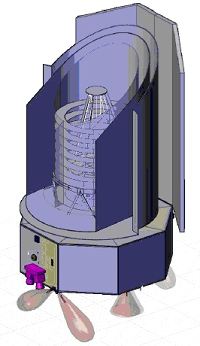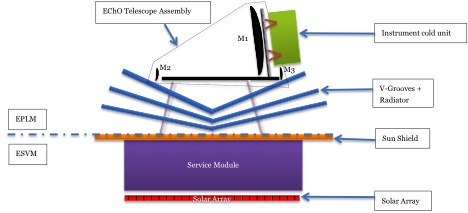Spacecraft
The EChO spacecraft is planned to be launched on a Soyuz rocket from Kourou, French Guiana, into a direct transfer orbit to the second Lagrangian point, L2. The spacecraft will have a launch mass no higher than 2.1 tonnes and will be made up of two principle modules:
- the payload module, which includes the telescope assembly, the EChO science instrument and the fine guidance sensor (FGS) along with some of the support equipment;
- the service module, which provides the majority of the means and resources required to support the payload and to keep the spacecraft running during all mission phases.
 |
The ESA CDF reference design concept for the EChO mission.
Concentric shields and baffles surround the telescope and provide the high degree of thermal shielding needed to achieve a telescope operating temperature of around Solar panels are accommodated on the Sun shield Credit: ESA |
Payload Module
An ESA study carried out at the Concurrent Design Facility (CDF) in ESTEC, the Netherlands, provided the reference design concept for the primary payload elements: a simple Cassegrain telescope with a field-of-view of 20“x20", and a spectrometer covering the 0.4 – 16 micron waveband. The payload has been the subject of detailed study in the period since the CDF: a new baseline telescope concept was selected following a trade-off of a number of different telescope designs which converged on an afocal, off-axis, Korsch-like system with a 1-m class diameter elliptical primary; the current spectrometer design covers the 0.4 – 11 micron waveband as a baseline, with an option to reach 16 micron.
 |
|
The conceptual design of the EChO spacecraft (payload module (EPLM) and service module (ESVM)), under investigation in the industrial studies. Since the EChO CDF reference design, the off-axis telescope has been accommodated horizontally on the SVM. Credit: ESA |
Service Module
The service module handles all functions needed to operate the payload, including the telemetry, power systems, thermal control and the attitude and orbit control systems (AOCS).
High photometric stability over a time scale of about 10 hours is one of the most stringent requirements of the EChO mission. As a result, fine pointing stability relative to the host star is mandatory. This will be achieved with a combination of a fine guidance sensor (FGS) that uses a fraction of the signal from the optical channel, and fine AOCS actuators.
